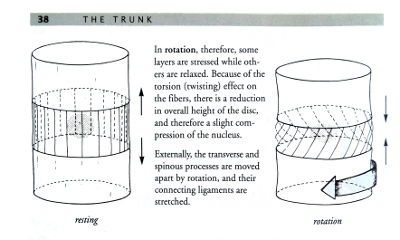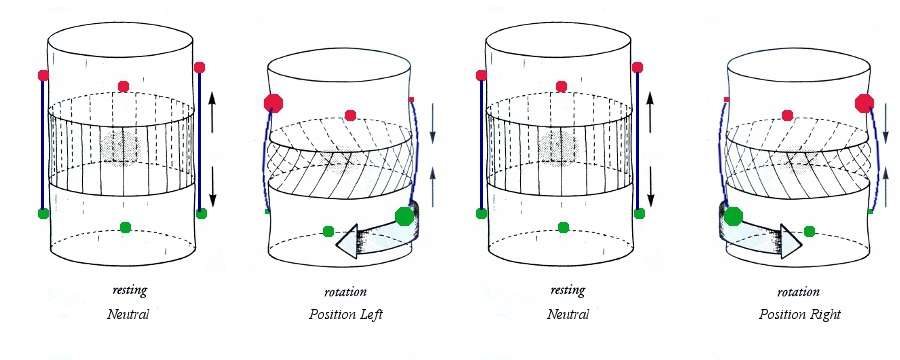Your Put Your Left Side In, You Put Your Left Side
Out
that's a bend?
This week in my Progressions Program the topic is 'Flexibility
Through Changes of Bend.' The key to this comes from
last week's Progression of 'Straightness through Bend' and
pivots upon understanding what bend actually is in a horse -- it's
actually a twirl or twist throughout the length of the
spine. This translates into the inside of the
horse's spine lifting and the outside of the horse's spine
dropping when it goes into position.
week in my Progressions Program the topic is 'Flexibility
Through Changes of Bend.' The key to this comes from
last week's Progression of 'Straightness through Bend' and
pivots upon understanding what bend actually is in a horse -- it's
actually a twirl or twist throughout the length of the
spine. This translates into the inside of the
horse's spine lifting and the outside of the horse's spine
dropping when it goes into position.
The diagram to the side, p 38 from Anatomy
of Movement by Blandine Calais-Germain, shows how fibers between the vertebra
twist with the effect of shortening the overall length of the spine. As
those fibers shorten, the transverse processes distance
themselves from each other, on both sides, stretching the
muscles on both sides of the spine.
This is similar to the ribbons in a candy cane.
When the taffy is twisted, the ribbons stretch.
During this week's progression, I am playing with how
evenly the twisting can happen in both directions -- and
how quickly I can go from the one to the other. Specifically,
I am finding out what I and the horse *can* do. I am
not making either the horse or myself twist more than is
absolutely comfortable (Ortho-bionomy concept) or faster
than we can learn from the experience. (Feldenkrais
concept.) I am looking for the range of movement I
can do. (Somatics concept.)
The exploration-exercise is a combination of a
Feldenkrais 'exercise' and a Somatics approach and was
inspired by a recent rediscovery of dermatomes.
<snip> OK - that got lengthy and off
track! Short version: where you feel pain is
necessarily where it's originating from. I've known
this for some time - was very impressed a few years ago to
find out Dr. Netter knew this, too, and put it into his
books - found out many medical texts have it as well.
Purchased some of these things and 'devoured' them.
Then life went on and that slid away until last week when I
got to thinking, "uh, flattened back, problems in arm
- are they related?" (why yes, they are!)
So as I contemplated the rides ahead and mentally reviewed
the rides from yesterday, I wondered "Hmmm.... stiff
horse, things not bending, parts-is-parts - are they
related?" (why yes, they are!) "What to do about
that?"
I think I know!
I learned the Feldenkrais 'exercise' from an
incredible Centered Riding instructor Sandra Code-Cabel.
She is extraordinary! The exercise she taught is
based upon exercises in the book
Relaxercise: The Easy New Way to Health and Fitness byDavid Zemach-Bersin, Kaethe Zemach-Bersin, Mark Reese and
is one I usually use at the Open Clinics I teach. For
that exercise, one twirls sections of the spine in a single
direction and comes back to neutral, repeating and adding
more sections until finally you have a beautiful 'bend' or
'position.' I often refer to this as the 'Lazy Susan'
exercise. It one that I use during the 'Straightness
through Bend' weeks of my program.
byDavid Zemach-Bersin, Kaethe Zemach-Bersin, Mark Reese and
is one I usually use at the Open Clinics I teach. For
that exercise, one twirls sections of the spine in a single
direction and comes back to neutral, repeating and adding
more sections until finally you have a beautiful 'bend' or
'position.' I often refer to this as the 'Lazy Susan'
exercise. It one that I use during the 'Straightness
through Bend' weeks of my program.
I got the Somatics approach from Thomas Hanna's book The Body of Life: Creating New Pathways for Sensory Awareness and Fluid Movement.
In it ,
Thomas Hanna recounts an elderly gentleman coming in
hunched over and shuffling. During that visit, he
articulated each vertebra along the spine - rotate left,
rotate right. And the man left with a definite skip
in his step! This inspired me to learn Somatics - not
that I went to school, but I delved into it! ,
Thomas Hanna recounts an elderly gentleman coming in
hunched over and shuffling. During that visit, he
articulated each vertebra along the spine - rotate left,
rotate right. And the man left with a definite skip
in his step! This inspired me to learn Somatics - not
that I went to school, but I delved into it!
Today's exercise blended the two.
Basically, it's neutral, 4 steps into position left, 4
steps back to neutral, 4 steps into position right, 4 steps
back to neutral, repeat -- all done with forward
movement. (as in, not lateral.) of course,
there are mis-steps but the idea is that it's a wavy line,
done with attention.
I attend to each articulation along the spine.
Today I started at the head with the C2/C1-skull
articulation, then did C2/C3 to C2/C1-skull, then did C4/C3
to C2/C3 to C2/C1-skull, working 'down' the spine.
If the head is at the top and we're looking at the
belly, then the 2nd diagram shows the left side 'lifting'
and the right side 'dropping' -- aka Position Left.
(if you get on all fours and lift your left shoulder off
the ground and drop your right shoulder towards the ground
- this is Position Left.) I drew in the dots and the
lines to help illustrate the movement. The bigger
dots are closer, the smaller ones further away. In
neutral position, the blue lines are at rest. When
the vertebra twirl relative to each other, the blue line
has to stretch to cover the longer distance. (The
blue line represents the small intertransversii msucles.
I didn't dray in the interspinales muscles but you can see
by the movement of the dots that they get stretched,
too.)

This a good thing for days when you would prefer
something quiet. It takes a lot of attention to
detail (not scrutiny!) and can, if you go on too long,
result in your brains dripping out your ears, so it's not
like I do this every day!
There's more to it, of course, but speaking of brains
starting to drip, I think I'll end here.
If you try it, let me know how it goes! And if
you'd like some hands on, call me up for a
lesson.
Cheers!
L
ps I'll just add, in Centered Riding, the
main concept is that whatever I'm doing with my own body,
I'm modeling for the horse to do in theirs. So you'll
notice I didn't say anything about which reins to use or
where to put my legs or anything. I do this all on a
loose rein. (unless the horse tries to exit stage left and
then I keep contact!)
|




![Centered Riding Today: An Informal Talk by Sally Swift [VHS]](http://ecx.images-amazon.com/images/I/41Vn6PfhzML._SL125_.jpg)
![Centered Riding with Sally Swift [VHS]](http://ecx.images-amazon.com/images/I/51OSh9kd9iL._SL125_.jpg)